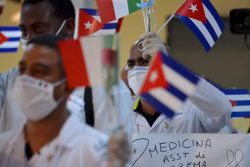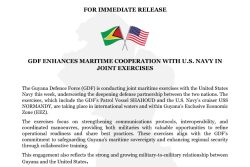Despite the efforts of the National Agricultural Research and Extension Institute (NAREI), the red palm mite is continuing to cause widespread destruction within the local coconut industry.
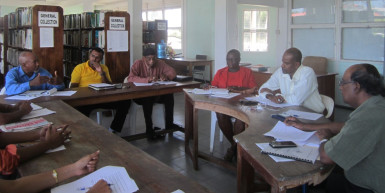
Addressing the Executive of the National Stakeholders Platform for Coconut Industry Development on Wednesday, Director of NAREI Dr Oudho Homenauth said the agency has been employing a range of approaches to manage the pest since the confirmation of its presence in Guyana in 2013. These efforts have included working with the United Nations Food and Agriculture Organisation (FAO) to develop a national management programme and action plan to deal with the pest.
However, farmers say the pest is continuing to wreak havoc in Guyana’s coconut industry and they are calling for NAREI and the government to do more to help them. The coconut is currently one of the country’s key non-traditional crops, with the industry ranking third behind rice and sugar as a priority agricultural crop. Coconuts currently contribute about 1% to the total Gross Domestic Product (GDP), with export pegged at US$3 million annually. There are an estimated 24,000 hectares under cultivation, producing an average of 92 million nuts each year.
Coconut is grown widely on the coastal regions, primarily along the Pomeroon River on the Essequibo Coast, West Berbice and on the Corentyne Coast. All of these areas are currently infested with palm mites.
The red palm mite (Raoiella indica), a pest of several palm species, uses it stylet-like mouthparts (chelicerae) to pierce the plant tissue and extract cell contents. This action damages the guard cells of the leaves, leading to uncontrollable water loss from the plant. The leaves yellow, then brown before eventually dying and taking the plant with it.
The red mite, which was first identified in the Caribbean in 2003, has been identified by the FAO as the most damaging pest to coconuts in many Caribbean countries. Since then, it has spread, presumably by wind currents, to more than 12 Caribbean countries, including Guyana.
On Wednesday, the National Stakeholders Platform for Coconut Industry Development had its third executive meeting at NAREI, where Homenauth led a discussion on the plan of action being utilised to manage the pest.
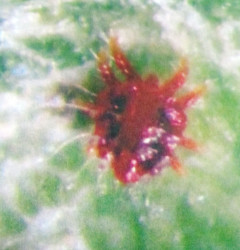
Homenauth explained that the first case of palm mite infestation in Guyana was recorded in Wakenaam in July, 2013. According to the director, with confirmation of the presence of the pest, NAREI immediately instituted internationally-outlined procedures, beginning with monitoring and surveillance efforts to prevent the spread of the pest.
“We established a quarantine area in Wakenaam and Leguan. Measures were put in place at all island exits. All material, including brooms, was treated before they left the island and this was done on the days we knew things regularly left the island,” Homenauth said.
He explained that while these measures were being taken, there were several other activities occurring simultaneously.
The area was mapped, with all the infected estates and trees being recorded and data was collected so that the population size of the red palm mite could be determined.
At the time, NAREI also instituted what it saw as its only option, “chemical controls.” Inosan, a Monocrotophos-based pesticide, was used on the older, larger trees after the nuts were harvested.
Despite these efforts, the pest was observed travelling down the Essequibo River and in the last quarter of 2013 its presence was confirmed in both the Pomeroon and on the East Coast Demerara.
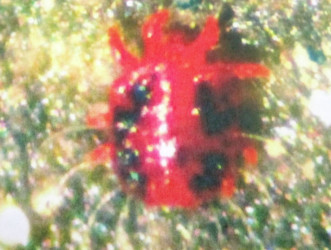
In the face of this wide-scale population expansion, NAREI extended its programme. In excess of 50,000 trees along the East Coast were treated with Inosan under the supervision of the extension officers, while younger trees, especially those to be harvested for water coconuts, were treated with abemictin.
Recognising that it could not sustain its efforts, which were proving quite costly as everything was being provided to farmers free of cost, NAREI sought more permanent solutions.
It began a search for natural enemies, so that long term controls could be instituted and this led to the discovery of small populations of the lacewing beetle, whose larvae feed on the RPM eggs.
Simultaneously, efforts were made to secure technical assistance, which was provided by the FAO.
The FAO, which strives as part of its strategic objectives to eliminate food insecurity by making agriculture productive and sustainable and increasing the resilience of livelihoods to threats, responded by funding a project to “Develop a National Integrated Management Programme and Action Plan for the RPM (Raoiella indica) in Guyana.”
According to the FAO website, “there is limited technical capacity in Guyana to develop the comprehensive programme needed to address this complex and difficult challenge,” thus the US$19,000 project was instituted to conduct a baseline study of the current status of the red palm mite in Guyana and management practices; conduct technical and stakeholder consultations, geared towards formulation and endorsement of a comprehensive nation-wide management programme for the pest and an action plan for its implementation; and to finalise the programme and plan.
The project began in November, 2014, and ended in May, 2015, with the report being finalised in July, according to Homenauth. The bulk of the activities were conducted between March 8 and March 21, when Trinidadian palm mite consultant Farzan Hosein visited Guyana.
According to the report, Hosein was able to determine that the action was “a well thought out road map on the way forward.”
Bad
For devastated farmers, however, more needs to be done. At the centre of the disagreement between the authorities and farmers is the pesticide Monocrotophos.
Those who have been growing coconuts for decades are saying that the only effective treatment for the red palm mite is Monocrotophos. However, while NAREI first began the pest management using a Monocrotophos-based pesticide, it has since discontinued its use for the more environmentally friendly, albeit slower-acting abamectin.
In July, Homenauth had told Stabroek News that Monocrotophos’ classification as a persistent organic pollutant that is extremely toxic to birds and humans makes it too hazardous for widespread use.
As a result, NAREI is currently proposing an integrated approach for the management of the pest.
Homenauth explained that after treatment with chemicals, coconut farmers need to pay attention to sanitation. “Without proper sanitation, whatever we do would not be meaningful because we have crops that are present nearby or within the plantation which are host to the palm mite,” he said.
He identified suckers plants, such as plantain and banana, as well as the wild heliconia as some of the most prevalent palm mite hosts present on coconut estates.
He also stressed the need for farmers to practise intensive fertilisation, so as to compensate for the nutrients lost due to the presence of the pest.
Brothers Suresh and Ganesh Gopaul, who together cultivate 45 acres of coconuts at Clonbrook, East Coast Demerara, told Stabroek News on Wednesday that the palm mite is devastating their crop.
“The red mite, right now, get the coconut trees bad. Right now the tree red, red and the coconut nah hold,” Suresh explained.
The brothers say that while the Monocrotophos-based pesticide that NAREI had used on the plants earlier this year led to improvements, these improvements were short-term.
“NAREI de give we some Monocrotophos early part of this year and we de see improvements but it wear off an’ now the mite come back,” Suresh said.
The brothers, who harvest both water coconuts and dry coconuts for the local market, say the infestation has cut their harvest by at least 50%. Suresh explained that before the infestation, his 24 acres were producing about 3,000 to 4,000 nuts a week but now they are only producing about 2,000 nuts a week.
Ganesh has been hit a lot harder; his 21 acres, which once produced 4,000 nuts a week, now yield around 500 to 600 nuts a week.
Both brothers are calling for NAREI to make the chemical available for purchase. They, however, admitted that they have not tried to use the recommended abamectin to combat the pest on the older plants.
The brothers also note that they have been utilising aspects of the recommended integrated approach as they employ weeders to keep their estates clean. Their efforts are, however, stymied by the negligence of some of those on neighbouring estates. They explain that several neighbouring estates have been abandoned and, therefore, remain cluttered with the falling leaves and other shrub.
Homenauth explained that these abandoned farms serve as a breeding ground for the palm mite, which spreads unchecked on those estates and from there to other estates.
According to the Gopauls, while these neighbours are aware of the problems created by their abandoned farms, they don’t care to do anything about it because they don’t see money in it for themselves.
While the Gopauls and other Clonbrook farmers, such has Mohammed Yar and Bodhan Singh, are grateful for the help that was offered by NAREI and the FAO, they would like to see more done.
“We went to NAREI a few months ago and they had the guy from Trinidad [Hosein] and he showed us how to treat the tree with the Monocrotophos and then NAREI came to the farm and treat some of the tree but that only work for like six months. It wuk out the tree and now you not getting the Monocrotophos anywhere,” Ganesh said.
In neighbouring Trinidad, it has been observed that red palm mite populations have caused significant damage to banana and plantain plants. While the mite has also been observed on ginger, heliconia, and bird of paradise plants in the twin island republic, the most significant damage caused has been on the coconut, date palm, areca palm and banana.





